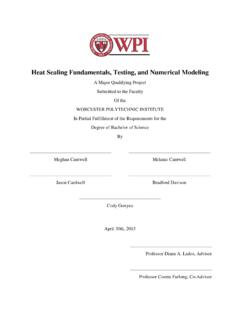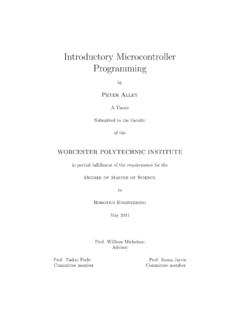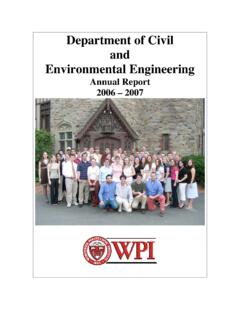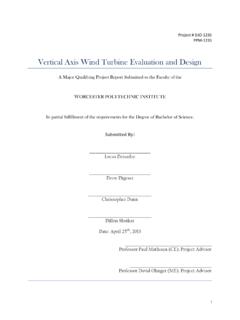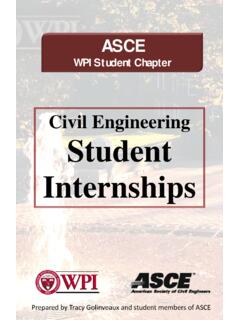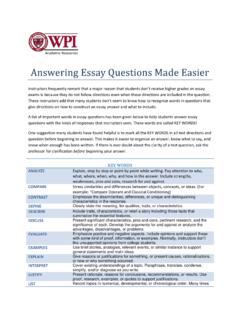Transcription of Rainwater Energy Harvesting - Worcester Polytechnic Institute
1 Carolyn Detora, Kayleah Griffen, Nicole Luiz, and Basak Soylu Worcester Polytechnic Institute Energy Harvesting from Rainwater 1 Abstract The purpose of this project was to provide electricity that was sufficient for powering lights and charging cell phones in rainy locations with limited electricity access. A household Rainwater Energy Harvesting system was researched, designed, prototyped, and tested to determine the feasibility of Rainwater as a source of renewable Energy . The system prototyped consisted of a gutter assembly that collected and funneled water from the roof to a downspout.
2 The downspout shielded the stream of water from wind and directed it to a turbine at the ground level. The turbine was connected through a gear train to a DC motor serving as the generator. The device is optimal during high rainfall intensities that produce larger flow rates. An Overshot water wheel, Crossflow turbine, and Pelton wheel turbine were evaluated under 8, 6, 4, and 2 gallons per minute flow rates using a tachometer and a torque meter. These flows were based on Liberian rainfall intensities scaled to a representative house that was 5 by 3 meters in roof area. The most suitable turbine was a 20 centimeter diameter Pelton wheel with 23 equally spaced blades.
3 A micro gear motor rated at a maximum speed of 460 RPM and a stall torque of 20 ounce-inch was selected to serve as the generator. The system produced a power of Watts and a efficiency at 8 GPM. When scaled for the rainfall in the month of June, the current system could charge about cell phones. This project proved the concept and design of a Rainwater Energy Harvesting system. The system could be combined with a filtration system and holding tank to collect drinkable water so that the system serves a dual purpose for people with limited access to electricity and water. 2 Table of Contents Abstract.
4 1 Table of Figures .. 4 Introduction .. 6 Background .. 8 Types of Hydropower .. 8 Storage Hydropower .. 8 Pumped-Storage Hydropower .. 9 Offshore Hydropower .. 9 Run-of-River Hydropower .. 9 Types of Turbines .. 10 Impulse Turbines .. 10 Reaction Turbines .. 12 Waterwheels .. 13 Pico-Hydro Power Generation .. 14 Electrical Components .. 14 Energy Harvesting from Rainwater for Household Systems .. 16 3 Design and Construction .. 18 System Components, Initial Design, and Project Scope .. 18 Project Scope .. 19 Initial Power Calculation .. 20 Prototype for Testing Structure.
5 29 Gutter and Downspout Sub-System .. 32 Gutter Sizing and Slope .. 32 Gutter-to-Downspout Connection Types .. 43 Gutter-to-Downspout Connection Tests .. 45 Downspout Consideration .. 51 Turbine Selection .. 52 Description and 3D Printing of Turbines for Preliminary Testing .. 53 SolidWorks Simulations .. 56 Preliminary Stall Torque and RPM Testing .. 62 Design and Optimization of Pelton and Crossflow .. 63 Final Turbine Selection .. 66 3 Electrical Component Selection .. 72 Design Tree Summary .. 77 Testing and Results .. 78 RPM and Torque Testing .. 78 RPM and Torque Testing Results.
6 79 Theoretical Validation of RPM and Torque Testing .. 80 Full System 83 Full System 83 Theoretical Determination of the Angular Velocity in the Full System Results .. 85 Loss Considerations and Efficiency .. 86 Conclusions and Recommendations .. 88 88 Recommendations for Future Work .. 89 References .. 91 Appendix A: Sizing of Rectangular and Half Round Gutters for English and Metric Units .. 94 Appendix B: Overshot Water Wheel Assembly Drawings .. 96 Appendix C: Pelton Wheel Assembly Drawings .. 97 Appendix D: Crossflow Turbine Assembly Drawings .. 98 Appendix E: SolidWorks Static Simulations Overshot Water Wheel.
7 99 Appendix F: SolidWorks Static Simulations Pelton Wheel .. 100 Appendix G: SolidWorks Static Simulations Crossflow Turbine .. 101 4 Table of Figures Figure 1: Example Pelton Wheel .. 11 Figure 2: Example Crossflow Turbine .. 11 Figure 3: Example Propeller 12 Figure 4: Example Archmedes Screw .. 12 Figure 5: Example Overshot Water Wheel .. 13 Figure 6: Example Backshot Water Wheel .. 13 Figure 7: DC Motor Rotational Speed vs Torque .. 15 Figure 8: Assembly of Turbine .. 17 Figure 9: Initial Design .. 19 Figure 10: Home in liberia with Corrugated Roof .. 20 Figure 11: Circular Segment Filled by Water.
8 24 Figure 12: Theoretical Power Output of the Turbine vs Rainfall Intensity .. 27 Figure 13: Design of Test Structure .. 29 Figure 14: White Vinyl Hidden Hangers .. 30 Figure 15: Assembled Gutter .. 31 Figure 16: Exploded View of Turbine Stand .. 32 Figure 17: Depiction of Single Corrugation .. 33 Figure 18: Velocity Components .. 36 Figure 19: Elbow Connectors and Short Lengths of Downspout .. 43 Figure 20: Straight Downspout .. 44 Figure 21: Open End Gutter .. 44 Figure 22: Vertical Downspout .. 45 Figure 23: Bent Downspout .. 46 Figure 24: Funnels Placed on Top of Downspout .. 46 Figure 25: Stream Size for (a) Vertical Downspout, (b) Bent Downspout, (c) centimeter Funnel, (d) cm Funnel.
9 47 Figure 26: CAD Model of Overshot Water Wheel .. 53 Figure 27: 3D Printed Overshot Water Wheel (a) Front View (b) Side View .. 53 Figure 28: CAD Model of the Pelton Wheel .. 54 Figure 29: 3D Printed Pelton Wheel (a) Front View (b) Side View .. 54 Figure 30: CAD Model of Crossflow Turbine .. 55 Figure 31: CAD Model for 3D Printing of Crossflow Turbine (a) Top of Turbine (b) Blades and Bottom of Turbine .. 55 Figure 32: 3D Printed Crossflow Turbine (a) Top View (b) Side View .. 56 Figure 33: Steps for SolidWorks Simulation .. 57 Figure 34: Stress-Strain Curve of ABS .. 58 Figure 35: Overshot Water Wheel Pressure Points on SolidWorks Simulation.
10 58 Figure 36: Overshot Water Wheel Static Stress SolidWorks Simulation Results .. 59 Figure 37: Pelton Wheel Pressure Points on SolidWorks Simulation .. 59 Figure 38: Pelton Wheel Static Stress SolidWorks Simulation .. 60 Figure 39: Crossflow Turbine SolidWorks Simulation Pressure Points .. 61 Figure 40: Crossflow Turbine Static Stress SolidWorks Simulation .. 61 Figure 41: Optimized Pelton Wheel 20 centimeters (a) Top View (b) Side View .. 65 5 Figure 42: Optimized Crossflow Turbine 20 centimeter (a) Top View (b) Side View .. 66 Figure 43: Torque Angular Velocity and Angular Relationships.

